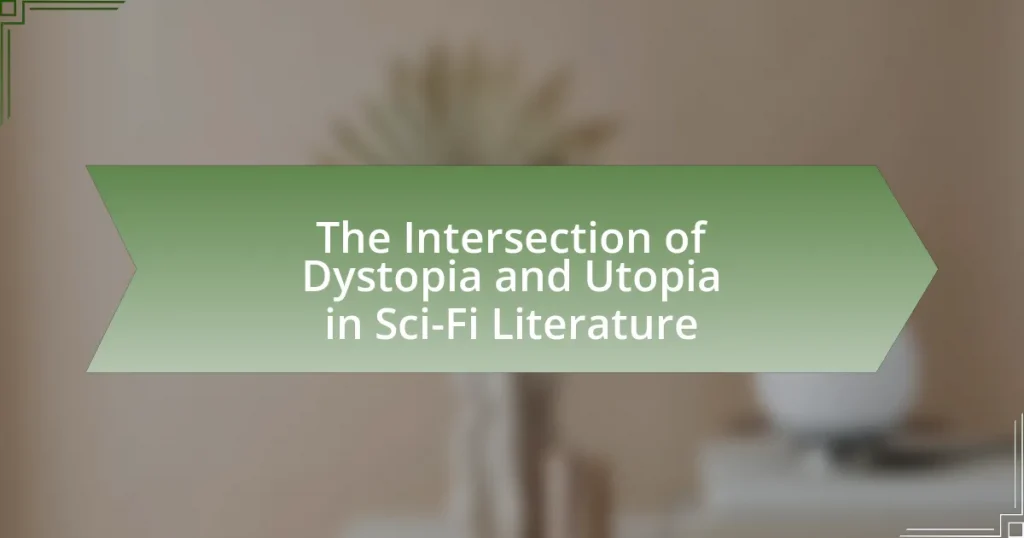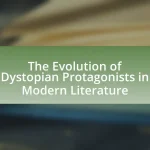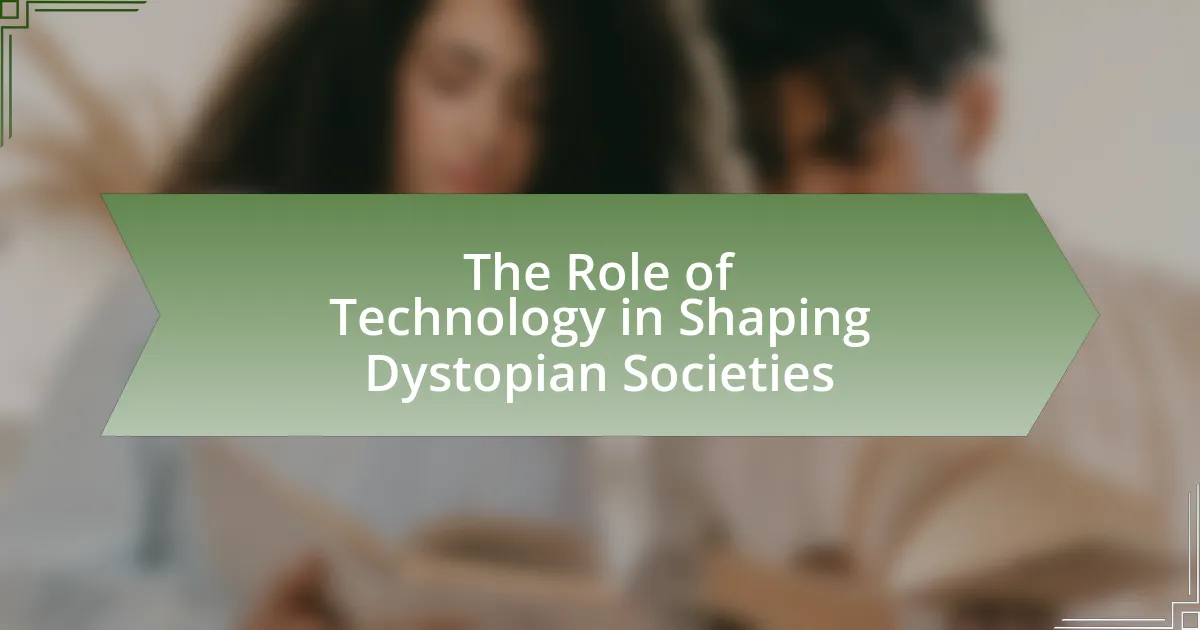The article examines the intersection of dystopia and utopia in sci-fi literature, highlighting how idealized visions of society often contrast with their flawed realities. It discusses key works such as Aldous Huxley’s “Brave New World” and George Orwell’s “1984,” illustrating the moral dilemmas and societal critiques embedded within these narratives. The article further explores the defining characteristics of dystopian and utopian literature, their thematic manifestations, and the influence of societal contexts on these genres. Additionally, it addresses how these narratives reflect contemporary fears and hopes, inspire social movements, and provide insights for navigating future challenges.
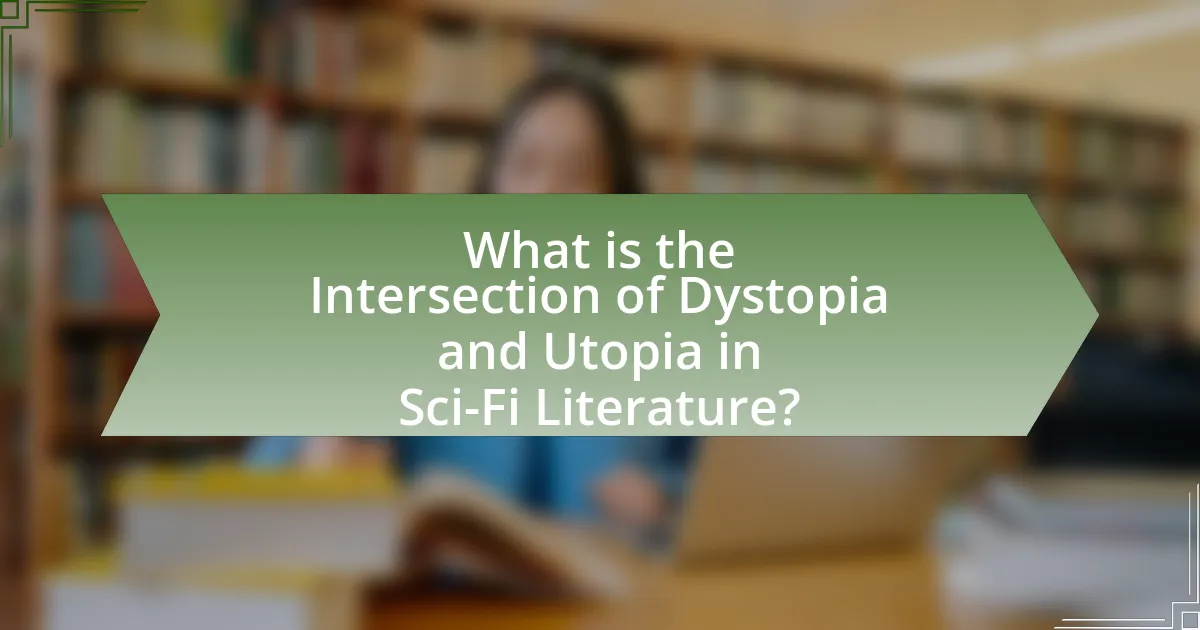
What is the Intersection of Dystopia and Utopia in Sci-Fi Literature?
The intersection of dystopia and utopia in sci-fi literature represents a complex relationship where idealized visions of society are often juxtaposed with their darker, flawed realities. This duality is evident in works like Aldous Huxley’s “Brave New World,” which presents a seemingly perfect society that sacrifices individuality and freedom, highlighting the fragility of utopian ideals. Similarly, George Orwell’s “1984” explores a totalitarian regime that emerges from the pursuit of a utopian vision, illustrating how the quest for a perfect society can lead to oppressive dystopian outcomes. These narratives demonstrate that the boundaries between utopia and dystopia are often blurred, revealing the inherent risks and moral dilemmas in striving for an ideal world.
How do dystopian and utopian themes manifest in sci-fi literature?
Dystopian and utopian themes manifest in sci-fi literature through contrasting depictions of society, technology, and human nature. Dystopian narratives often explore oppressive governments, environmental collapse, and societal decay, as seen in works like George Orwell’s “1984,” which critiques totalitarianism and surveillance. In contrast, utopian themes present idealized societies where technology and social structures promote harmony and equality, exemplified by Aldous Huxley’s “Brave New World,” which, while initially appearing utopian, reveals underlying issues of conformity and control. These themes serve to reflect contemporary societal anxieties and aspirations, illustrating the potential consequences of current trends in governance, technology, and ethics.
What are the defining characteristics of dystopian literature?
Dystopian literature is characterized by a society that is often oppressive, controlled, and marked by a loss of individuality and freedom. Common elements include totalitarian governments, environmental disasters, dehumanization, and the exploration of social and political themes that critique contemporary society. For instance, George Orwell’s “1984” exemplifies a totalitarian regime that surveils and manipulates its citizens, illustrating the dangers of oppressive governance. Additionally, dystopian narratives frequently depict a stark contrast between the idealized vision of society and the grim reality, highlighting the consequences of unchecked power and technological advancement.
What are the defining characteristics of utopian literature?
Utopian literature is characterized by the depiction of an ideal society that embodies perfection in various aspects such as social, political, and economic structures. These works often explore themes of harmony, equality, and the elimination of societal issues like poverty and crime. Notable examples include Thomas More’s “Utopia,” which presents a fictional island society with communal ownership and social justice, and Edward Bellamy’s “Looking Backward,” which envisions a future of economic equality and social cooperation. These texts serve as critiques of contemporary society, proposing alternative ways of living that challenge existing norms and inspire readers to envision a better world.
Why is the exploration of dystopia and utopia significant in sci-fi?
The exploration of dystopia and utopia is significant in sci-fi because it allows for critical examination of societal values and potential futures. Sci-fi serves as a mirror reflecting contemporary issues, enabling readers to envision the consequences of current trends, such as technological advancement and political systems. For instance, George Orwell’s “1984” illustrates the dangers of totalitarianism, while Aldous Huxley’s “Brave New World” critiques consumerism and loss of individuality. These narratives provoke thought and discussion about the direction of society, encouraging readers to consider ethical implications and the importance of choice in shaping their realities.
How do these themes reflect societal fears and hopes?
Themes in sci-fi literature that explore dystopia and utopia reflect societal fears and hopes by illustrating the consequences of current societal trends and envisioning ideal futures. For instance, works like George Orwell’s “1984” highlight fears of totalitarianism and loss of individual freedoms, mirroring contemporary concerns about surveillance and government overreach. Conversely, utopian narratives, such as those found in Ursula K. Le Guin’s “The Dispossessed,” express hopes for social equity and communal living, suggesting pathways to a more just society. These contrasting themes serve as a lens through which readers can examine their own societal conditions, fears of technological advancement, and aspirations for a better future.
What role does speculative fiction play in shaping perceptions of reality?
Speculative fiction plays a crucial role in shaping perceptions of reality by exploring alternative worlds and futures that challenge existing societal norms and values. This genre allows readers to envision possibilities beyond their current circumstances, prompting critical reflection on contemporary issues such as technology, governance, and social justice. For instance, George Orwell’s “1984” illustrates the dangers of totalitarianism, influencing public discourse on surveillance and personal freedoms. Similarly, Margaret Atwood’s “The Handmaid’s Tale” critiques patriarchal structures, impacting discussions around women’s rights and autonomy. Through these narratives, speculative fiction not only entertains but also serves as a lens through which readers can examine and question their own realities, fostering awareness and inspiring change.
What are some notable examples of dystopian and utopian sci-fi works?
Notable examples of dystopian sci-fi works include “1984” by George Orwell, which depicts a totalitarian regime that exercises extreme control over its citizens, and “The Handmaid’s Tale” by Margaret Atwood, which explores a theocratic society that subjugates women. Utopian examples include “Utopia” by Thomas More, which presents an ideal society based on communal living and equality, and “The Dispossessed” by Ursula K. Le Guin, which contrasts anarchist and capitalist societies to explore themes of freedom and societal structure. These works illustrate the spectrum of societal possibilities, highlighting the consequences of political and social structures.
Which authors are most influential in this genre?
The most influential authors in the intersection of dystopia and utopia in sci-fi literature are George Orwell, Aldous Huxley, and Margaret Atwood. George Orwell’s “1984” presents a chilling dystopian vision that critiques totalitarianism, while Aldous Huxley’s “Brave New World” explores a technologically advanced society that sacrifices individuality for stability. Margaret Atwood’s “The Handmaid’s Tale” examines themes of oppression and gender, reflecting societal fears and potential futures. These authors have shaped the genre by addressing critical social issues and influencing subsequent works in dystopian and utopian narratives.
What are the key narratives that illustrate this intersection?
Key narratives illustrating the intersection of dystopia and utopia in sci-fi literature include “Brave New World” by Aldous Huxley and “1984” by George Orwell. In “Brave New World,” a seemingly utopian society prioritizes happiness and stability through technological control, revealing the dark underbelly of enforced conformity and loss of individuality. Conversely, “1984” presents a dystopian reality where totalitarianism suppresses freedom and truth, yet it also critiques the potential for a utopian vision to devolve into oppression. These narratives exemplify how the pursuit of an ideal society can lead to dystopian outcomes, highlighting the fragile balance between utopia and dystopia.

How do dystopian and utopian narratives influence each other?
Dystopian and utopian narratives influence each other through a reciprocal relationship where each serves as a critique or aspiration for the other. Dystopian narratives often highlight the flaws and dangers of societal structures, prompting readers to envision utopian alternatives that address these issues. Conversely, utopian narratives can reveal the potential pitfalls of idealism, showcasing how the pursuit of a perfect society can lead to oppressive regimes, as seen in works like Aldous Huxley’s “Brave New World,” which critiques utopian ideals by depicting a controlled, dystopian reality. This interplay encourages critical reflection on societal values and the feasibility of achieving a perfect world, demonstrating how each genre informs and shapes the other.
What common elements exist between dystopian and utopian stories?
Dystopian and utopian stories share common elements such as the exploration of societal structures and the human condition. Both genres often depict a vision of society that reflects the author’s commentary on current social, political, or technological issues. For instance, they frequently utilize a central conflict that highlights the tension between individual freedom and societal control, as seen in works like George Orwell’s “1984” and Aldous Huxley’s “Brave New World,” which illustrate the consequences of extreme governance. Additionally, both genres often feature a protagonist who challenges the status quo, representing hope or resistance, which serves to engage readers in contemplating the implications of their own societal realities.
How do authors use contrasts to enhance their narratives?
Authors use contrasts to enhance their narratives by juxtaposing opposing elements, such as utopian ideals against dystopian realities, to create tension and provoke thought. This technique allows readers to explore the complexities of human experience and societal structures. For instance, in George Orwell’s “1984,” the stark contrast between the oppressive regime and the fleeting moments of hope highlights the fragility of freedom, prompting readers to reflect on the implications of totalitarianism. Such contrasts not only deepen character development but also enrich thematic exploration, making the narrative more engaging and thought-provoking.
What themes are often shared between dystopian and utopian works?
Dystopian and utopian works often share themes of societal structure, human nature, and the consequences of technological advancement. Both genres explore the ideal versus the flawed aspects of society, examining how systems of governance and social organization impact individual lives. For instance, George Orwell’s “1984” and Aldous Huxley’s “Brave New World” highlight the dangers of totalitarianism and the loss of individuality, while utopian works like Thomas More’s “Utopia” and Ursula K. Le Guin’s “The Dispossessed” envision societies striving for equality and harmony. These narratives reflect on the potential outcomes of human choices, emphasizing the thin line between utopia and dystopia, as seen in the contrasting visions of a perfect society that can quickly devolve into oppression.
How do societal contexts shape these narratives?
Societal contexts significantly shape narratives in sci-fi literature by influencing themes, character development, and plot structures. For instance, during periods of political unrest, such as the Cold War, dystopian narratives often reflected societal fears of totalitarianism and nuclear annihilation, as seen in George Orwell’s “1984.” Conversely, utopian narratives frequently emerge in times of social progress, showcasing ideals of equality and technological advancement, exemplified by works like Aldous Huxley’s “Brave New World.” These narratives serve as reflections of contemporary societal values, anxieties, and aspirations, demonstrating how the context in which they are created directly impacts their content and message.
What historical events have influenced dystopian and utopian literature?
The historical events that have influenced dystopian and utopian literature include the Industrial Revolution, World Wars, and the Cold War. The Industrial Revolution, which began in the late 18th century, led to rapid urbanization and social changes, prompting authors like Charles Dickens to explore themes of inequality and societal collapse. The devastation of World War I and World War II inspired works such as George Orwell’s “1984” and Aldous Huxley’s “Brave New World,” reflecting fears of totalitarianism and loss of individuality. Additionally, the Cold War era, marked by nuclear threats and ideological conflicts, influenced literature like Ray Bradbury’s “Fahrenheit 451,” which critiques censorship and conformity. These events shaped the thematic concerns and narrative structures of dystopian and utopian literature, making them reflections of societal anxieties and aspirations.
How do cultural perspectives alter the interpretation of these themes?
Cultural perspectives significantly alter the interpretation of dystopian and utopian themes in sci-fi literature by shaping the values, beliefs, and experiences that inform readers’ understanding. For instance, a society that prioritizes individualism may interpret a dystopian narrative as a cautionary tale against government overreach, while a collectivist culture might view the same narrative as a critique of societal fragmentation. This divergence is evident in works like George Orwell’s “1984,” where Western readers often focus on themes of personal freedom, whereas Eastern readers might emphasize the role of community and social harmony. Such variations highlight how cultural backgrounds influence the lens through which themes are perceived, ultimately affecting the moral and philosophical conclusions drawn from the literature.
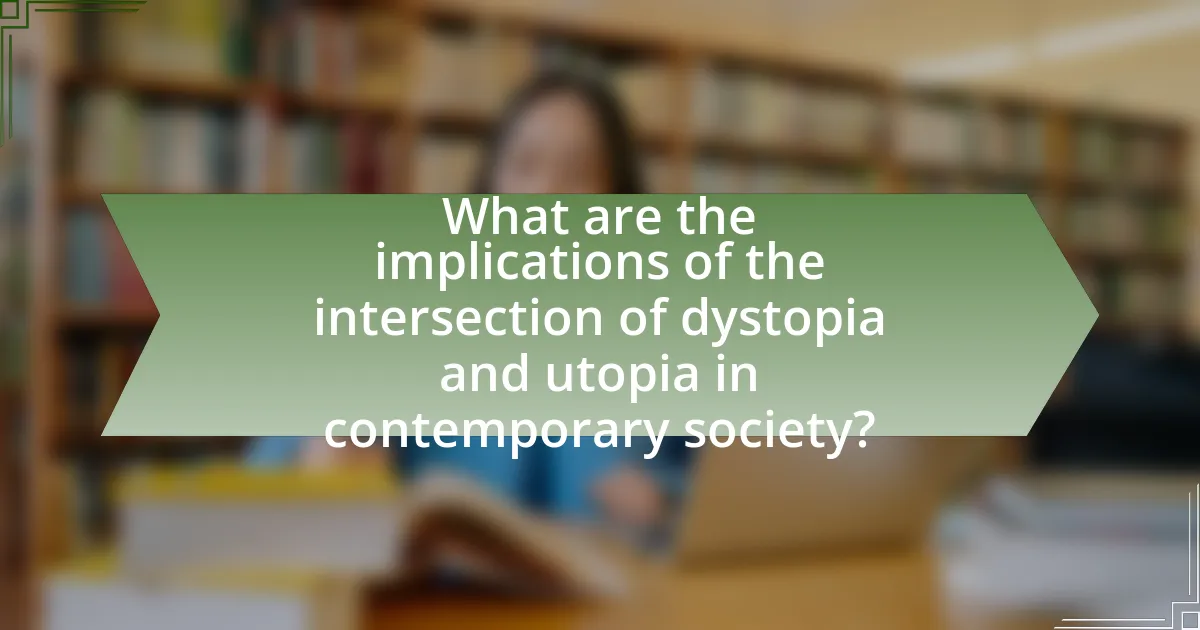
What are the implications of the intersection of dystopia and utopia in contemporary society?
The intersection of dystopia and utopia in contemporary society implies a complex relationship where idealistic visions often highlight societal flaws, leading to critical discourse on governance, technology, and human rights. This duality is evident in various media, such as literature and film, where utopian ideals serve as a benchmark against which dystopian realities are measured. For instance, George Orwell’s “1984” critiques totalitarianism, prompting discussions about surveillance and personal freedoms, while works like Aldous Huxley’s “Brave New World” explore the consequences of technological advancements on human relationships and individuality. These narratives reflect societal anxieties and aspirations, influencing public perception and policy regarding social justice, environmental sustainability, and ethical governance.
How do these themes resonate with current global issues?
The themes of dystopia and utopia in sci-fi literature resonate with current global issues by reflecting societal anxieties and aspirations regarding technology, governance, and environmental sustainability. For instance, the rise of surveillance technologies and authoritarian governance in various countries mirrors dystopian narratives, such as those found in George Orwell’s “1984,” highlighting concerns over privacy and civil liberties. Additionally, the increasing urgency of climate change, as depicted in works like Kim Stanley Robinson’s “The Ministry for the Future,” emphasizes the need for utopian visions that prioritize sustainable living and global cooperation. These literary themes serve as cautionary tales and sources of inspiration, prompting discussions about the direction of humanity in the face of pressing challenges.
What parallels can be drawn between fiction and real-world challenges?
Fiction often mirrors real-world challenges by exploring themes such as societal inequality, environmental degradation, and authoritarian governance. For instance, dystopian novels like “1984” by George Orwell illustrate the dangers of totalitarian regimes, reflecting contemporary concerns about surveillance and loss of privacy. Similarly, “The Handmaid’s Tale” by Margaret Atwood addresses issues of gender oppression and reproductive rights, paralleling ongoing debates in various societies. These narratives serve as cautionary tales, prompting readers to consider the implications of current social and political trends, thereby reinforcing the relevance of fiction in understanding and critiquing real-world issues.
How do dystopian and utopian narratives inspire social movements?
Dystopian and utopian narratives inspire social movements by providing frameworks for critique and envisioning alternatives to existing societal structures. These narratives often highlight systemic injustices, prompting individuals and groups to mobilize for change. For instance, George Orwell’s “1984” serves as a cautionary tale about totalitarianism, motivating activists to resist oppressive regimes. Similarly, utopian works like Thomas More’s “Utopia” encourage the exploration of ideal societies, inspiring movements aimed at social reform. Historical examples include the civil rights movement, which drew on dystopian imagery to illustrate racial oppression, and the environmental movement, which utilizes utopian visions of sustainability to advocate for ecological justice.
What lessons can readers learn from the intersection of these themes?
Readers can learn that the intersection of dystopia and utopia in sci-fi literature highlights the complexities of human society and the consequences of technological and social advancements. This duality illustrates that ideal societies often contain underlying flaws that can lead to oppressive conditions, as seen in works like George Orwell’s “1984” and Aldous Huxley’s “Brave New World.” These narratives serve as cautionary tales, emphasizing the importance of vigilance against authoritarianism and the need for ethical considerations in progress. By examining these themes, readers gain insights into the balance between aspiration and caution, understanding that the pursuit of a perfect society must be tempered with awareness of potential pitfalls.
How can understanding these narratives inform our approach to future challenges?
Understanding narratives in sci-fi literature, particularly those exploring dystopia and utopia, can inform our approach to future challenges by providing critical insights into societal values, potential consequences of technological advancements, and human behavior. These narratives often reflect real-world issues, such as climate change, inequality, and authoritarianism, allowing readers to analyze the implications of current trends. For instance, George Orwell’s “1984” illustrates the dangers of totalitarianism, prompting discussions on privacy and government surveillance in contemporary society. By examining these fictional scenarios, we can better anticipate and navigate the complexities of future challenges, fostering proactive solutions rather than reactive measures.
What practical insights can be gained from analyzing these literary themes?
Analyzing the literary themes of dystopia and utopia in sci-fi literature provides practical insights into societal values and human behavior. These themes often reflect contemporary issues, such as government control, environmental degradation, and technological advancements, allowing readers to critically assess their own world. For instance, George Orwell’s “1984” illustrates the dangers of totalitarianism, prompting discussions about privacy and surveillance in modern society. Similarly, works like Aldous Huxley’s “Brave New World” explore the implications of consumerism and genetic engineering, encouraging reflection on ethical considerations in scientific progress. By examining these themes, individuals can better understand potential futures and the consequences of current choices, fostering informed civic engagement and ethical decision-making.
